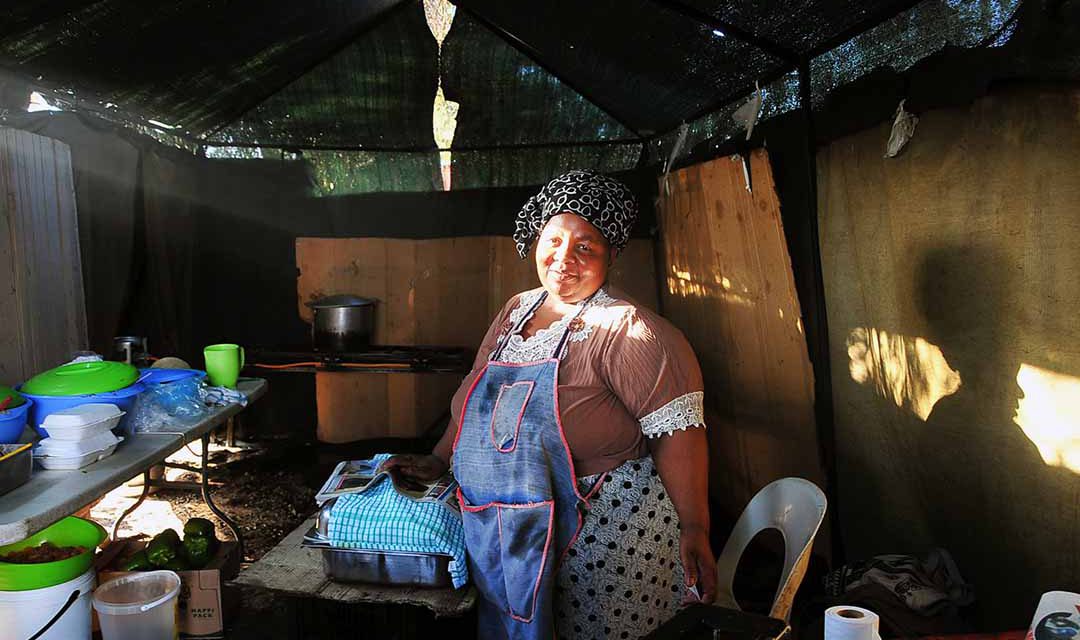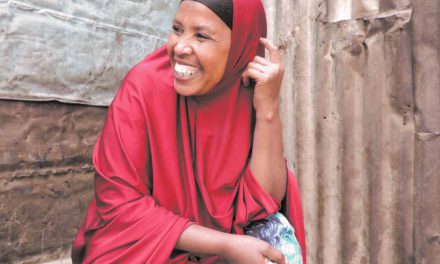In the face of soaring unemployment, women informal traders in one South African provincial capital are earning a good living – and creating jobs
When Manoko Moloto was still employed as a general worker at a school, she never thought she would one day join the ranks of informal traders in her home town, Polokwane, capital of South Africa’s Limpopo province. But after she was retrenched in 1993, she joined the hustle of traders who stocked goods they would source from the coastal city of Durban, some 800 km away, to resell in the streets of Polokwane.
Moloto found the business lucrative but stopped after some of her peers were killed in a road accident. Instead, she started cooking, serving meals to travellers on Dahl Street in Polokwane. She then gave up the stall in favour of more formal employment and went to work as a store assistant, but when she was retrenched again she returned to Dahl Street and worked harder to establish her business.
Now, business is good and Moloto employs four full-time staff, occasionally beefing up her staff with casual workers on days when her stall is very busy, especially on weekends and at month end. “When I was still employed, I used to wonder how these people [hawkers] managed to support their families and I never thought that one day I would be one of them,” she says. “But now I know that this business helps people build homes and raise children.”
Her stall, strategically located on the bustling corner of Dahl and Thabo Mbeki streets in the Limpopo capital, is popular with travellers and shoppers looking for a traditional South African meal.
One side of Dahl Street is lined with liquor stores, taverns, take-away cafés, car spare-parts shops, informal mechanics, tyre repairmen and general stores. On the opposite side of the road, near an old cemetery and taxi rank, the pavement is lined with stalls of varying kinds, shacks built from zinc, shade cloths made from nets, branded gazebos and tents. It is here that scores of people sit down daily for a meal at the informal restaurants housed under these structures.
The menu ranges from pap (stiff porridge), beef and chicken stews to beef steak and whole chickens roasted over fires or cooked on gas stoves right there on the pavement. And although there are many formal restaurants serving similar meals in town, it appears many consumers prefer these informal stalls run by entrepreneurs like Moloto.
From an outsider’s perspective, this kind of business may not look attractive or even lucrative, but it is this kind of enterprise that is allowing people like Moloto to raise families, school their children and build homes that many in formal employment can only dream of. On a good day, hawkers like Moloto serve an average of at least 60 clients. The business is much busier on weekends when travellers pass through the town on their way to destinations far away – but it is also kept busy by the loyal stream of clients who eat here daily from late morning until dusk on weekdays.
With a pap and chicken or beef meal selling from R40 (about $3) a serving, the food vendors make an average of about R3,000 (about $215) a day. This, of course, doesn’t include the operational costs, including gas for cooking, boxes of chicken and beef, vegetables, maize meal and wages. However, the amount of money they turn over is still, on average, more than that earned by many employees in certain sectors in the formal economy.
The achievements of hawkers like Moloto are cause for celebration when taking into account the volatility of the South African labour market and the odds faced by small entrepreneurs.
In August 2018, the quarterly Labour Force Survey, released by Statistics South Africa (Stats SA), found that, regardless of race, the country’s labour market was more favourable to men than it was to women, and that men were more likely to be paid better than women. The survey put the unemployment rate in the second quarter of 2018 at 27,2%, an increase of 0,5 of a percentage point on the first quarter. The survey also found that the rate of unemployment among women was 29,5% in the second quarter of 2018 compared with 25,3% among men, according to the official definition of unemployment. The results from the Stats SA survey for the second quarter of 2018 also indicated that the rise in the unemployment rate in the second quarter was a result of a 90,000 reduction in the number of people in employment and an increase of 102,000 in the number of people who became unemployed between the first and second quarters of the year.
But enterprising women like Moloto are doing well for themselves and they are also helping to create jobs. Near where Moloto has her stall, sisters Lizzy and Emily Ramashilo are taking a breather in their zinc kitchen after a hectic day of cooking and serving clients. They started Lucy’s Kitchen in 1993, together with their elder sister, Lucy, who had been working for another food stall owner until he decided to concentrate on his taxi business instead.
“We were all unemployed then,” says Emily, reflecting on those early days. “There are no jobs, but God has given us these hands so that we can feed our families.”
With the income they have earned from Lucy’s Kitchen the three sisters have managed to build a house, buy furniture for themselves and put their children through school. In a country where many women are out of work or rely on their spouses and government social grants for support, Lucy’s Kitchen is a shining example of entrepreneurial achievement. “It is better than waiting for the government to provide jobs,” says Lizzy.
Meanwhile, Moloto hopes to double her workforce in the near future. “It will make me happy,” she says. “When you see people coming to beg for work and you can’t help them it’s sad. But when you see those that you employ smile at the end of the month then I feel I have made a difference.”
Lucas Ledwaba is the founder and editor of Mukurukuru Media, an agency specialising in feature articles and photographs. He is the author of Broke and Broken, The Shameful Legacy of Gold Mining in South Africa (2016) and co-author of We Are Going to Kill Each Other Today – The Marikana Story (2013). His work has appeared in the Mail & Guardian, the Sunday Times, City Press, Destiny magazine, Drum magazine and the African Times, among others. He has won several prestigious prizes for his feature writing, and his photographic work has been exhibited locally and in the USA.













